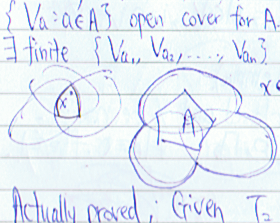To show that any compact Hausdorff space is $T_4$, one may first show that it’s $T_3$. To see this, using set theory notations may be quite difficult. For mediocre students, the contents of the following seciton may sound unnatural.
A sketch of the proof
Suppose that we want to separate a point $x \notin A$ and a closed set $A$ in a compact $T_2$ space $X$ by two disjoint open sets $U$ and $V$ so that $x \in U$ and $A \subseteq V$. A standard proof is to apply the $T_2$ property of $X$ to $x$ and each $y \in A$ so as to yield two disjoint open sets $U_y,V_y \in \mathcal{T}$ such that $x \in U_y$ and $y \in V_y$. Since $A$ should be contained in an open set $V$, in other words, an open cover of $A$ is needed, one might be tempted to construct the following union of open sets.
However, one can’t ensure that the following infinite intersection of open sets is open.
For instance, by the Nested Interval Theorem,
Thus, one applies the compactness of $X$ to get finite versions of \eqref{Vinf} and \eqref{Uinf}.
A snapshot of this fact
Since it’s so difficult to remember every detail of the proof, I love illustrating it using a picture.

How can a compact regular space be regular? See my next post.